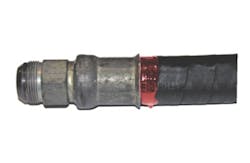Hydraulic Hose Leak
Hydraulic hoses are the lifeline for heavy equipment and machinery. They also take a beating. Rather than subscribing to the philosophy that eventually all hydraulic hoses break down, following a few best practices will extend the life of a hydraulic hose and keep machines up and running.
The three common causes of a hydraulic hose failure are site damage, wear and tear, and contaminated oil in the hydraulic system.
Site damage happens when equipment is working in an aggressive environment such as a scrap yard or a construction site. Exposed hoses can easily get struck, severed or crushed by outside objects such as sharp pieces of steel, concrete or rebar.
Wear and tear occurs due to the length of time the machinery or equipment is in service, when the exterior of the hose assembly has been exposed to the elements. In particular, ultraviolet light can cause the outer cover to become hard, start to crack and fall away. This, in turn, exposes the steel-wire reinforcement to the elements, which then rusts, leading to hose failure.
READ ALSO: 7 Fillers to Enhance the Performance of Virgin PTFE Sealing Systems
Other common causes due to wear and tear would be the failure to replace broken or missing hose brackets or clamps when servicing the equipment, leaving the hose assembly free to rub against parts of the equipment or exceeding the number of cycles, which the hose assembly was designed to carry out.
A little known fact is that the life of a hydraulic hose is often measured by the number of times the system cycles, not the age or length of service of the machinery or equipment.
Failures due to contamination occur when other parts of the hydraulic system start to break down, introducing small pieces of steel. These fragments, for example, could enter into the oil and may not be big enough to be captured by the filter units but still large enough to create abrasion of the inner liner. Other causes can include "opening" the hydraulic system to simply refill the oil, allowing the ingress of particles.
Abrasion
To reduce the amount of downtime due to a hose failure, here are five simple steps:
1. Examine the exposed hoses on equipment. By regularly inspecting your equipment, you will be able to identify any external damage or cuts to the outer cover. If damage is detected, replace these hoses and review the possibility of adding a protective textile or metal sleeve to protect the hose assembly before the equipment goes back into service. This preventative maintenance is often a lot cheaper than an unexpected hose failure on-site.
Exposed and Damaged Reinforcement
2. Reduce breakdowns caused by wear and tear. Introduce a checklist with images to inspect hose assemblies during routine maintenance. Look for hoses that are rubbing in their clamps, dampness behind the ferrule, rust or oxidization of the fittings, cracked or missing outer cover, and exposed wire reinforcement.
Cracked Cover
3. Reduce contamination in the system. An easy way to do this is by following the manufacturer's recommendations regarding the life cycle of components, changing oil and filters, and by keeping the hydraulic system clean by taking regular oil samples for analysis. In some applications there is a valid argument to place an additional filtration unit into the hydraulic system to maintain a low particle count.
While all these items can help with up time, there are other factors to consider.
4. Select a suitable vendor to oversee your company’s hydraulic-hose assemblies. Suitable vendors understand that cutting a hydraulic hose with a saw that uses metal blades or abrasive wheels generates a significant amount of heat. The heat will cause rubber dust and metal particle contaminants to stick to the hose tube as it cools.
PIRTEK uses a hose cleaning system where special foam pellets are fired through the hose prior to the assembly, which significantly reduces the contamination in a hydraulic system. The projectile should be fired through the hose prior to and after the end connections are installed.
5. Use a vendor that promotes using matched fittings. This means that the vendor should use hoses and fittings from the same manufacturer or a suitable combination, which has been impulse tested to the correct SAE requirements. Hose assemblies that have been "mixed and matched" without proper testing or certification can lead to early failure.
Damaged Fitting
To get the most out of your hoses and limit the chance of significant downtime, PIRTEK technicians promote a two-tiered approach. Preventative maintenance should be at the forefront of a company’s routine. This will help operators spot issues before they lead to significant downtime. Second, hire a hose provider that believes cleaning and tagging hoses and gives you a full range of contamination control options. This blueprint will keep equipment up and running, optimizing output and saving time and money.
Jamie Vokes has been the Director of Franchise Support for Pirtek USA since January 2003 and acted as a Consultant for Pirtek USA from April through December 2002. Prior to joining Pirtek USA, Vokes acquired more than 22 years’ experience in the PIRTEK system through his position as European Sales Manager for Pirtek Europe. Vokes also holds and maintains his Connector and Conductor Certification with the International Fluid Power Society.







